
USS Trout (SS-566), a Tang-class submarine, was the second ship of the United States Navy to be named for the trout.

Sea Control Squadron 21 (VS-21) was an aviation unit of the United States Navy. It served from 1945 to 2005 and was mainly tasked with anti-submarine warfare while operating from aircraft carriers. It was the only squadron to receive the designations VA-1E, VC-21, or VS-21.

USS Sicily (CVE-118) was a Commencement Bay-class escort carrier in the United States Navy. She was named in honor of the island of Sicily, which was the site of a major invasion during World War II. Sicily was laid down on 23 October 1944 by Todd-Pacific Shipyards, Tacoma, Washington, as Sandy Bay; launched on 14 April 1945; sponsored by Mrs. Julius Vanderwiele; renamed Sicily on 5 June 1945; and commissioned on 27 February 1946, Capt. B. W. Wright in command.

Strike Fighter Squadron 37 (VFA-37), also known as the "Ragin' Bulls", is a United States Navy F/A-18E Super Hornet fighter squadron stationed at Naval Air Station Oceana. They are a part of Carrier Air Wing 8 (CVW-8) and are attached to USS George H. W. Bush. Their radio callsign is Ragin' and their tail code is AJ.

USS Massey (DD-778), an Allen M. Sumner-class destroyer, was a United States Navy ship that served between 1944 and 1973.
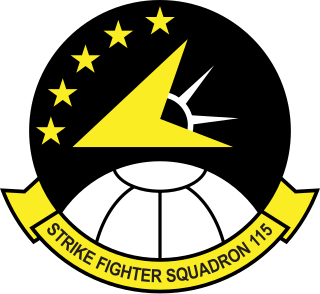
Strike Fighter Squadron 115 (VFA-115) is known as the "Eagles", callsign "Talon", a United States Navy F/A-18E Super Hornet strike fighter squadron stationed at Marine Corps Air Station Iwakuni. Their tail code is NF. It was established as Torpedo Squadron VT-11 on 10 October 1942, redesignated VA-12A on 15 November 1946, VA-115 on 15 July 1948, then finally VFA-115.

Strike Fighter Squadron 195 (VFA-195), also known as the "Dambusters", is a United States Navy F/A-18E Super Hornet fighter squadron stationed at Marine Corps Air Station Iwakuni, Japan. They are a part of Carrier Air Wing Five (CVW-5) and their tail code is NF. Their radio callsign is "Chippy".

HSC-7 Helicopter Sea Combat Squadron Seven, also known as the Dusty Dogs, is a United States Navy helicopter squadron located at Naval Station Norfolk. They are attached to Carrier Air Wing Three and deploy aboard USS Dwight D. Eisenhower.

Marine Fighter Squadron 123 (VMF-123) was a fighter squadron of the United States Marine Corps during World War II and later in the Marine Forces Reserve. Known as the “Flying Eight Balls,” the squadron fought at Guadalcanal, Iwo Jima, and Okinawa and served as a training squadron for replacement pilots during the Korean War. The squadron was decommissioned on October 31, 1965 at Naval Air Station Los Alamitos.

Strike Fighter Squadron 136 (VFA-136) also known as the "Knighthawks" is a United States Navy strike fighter squadron based at Naval Air Station Lemoore, California. The "Knighthawks" are an operational fleet squadron flying the F/A-18E Super Hornet. They are homeported at NAS Lemoore and are currently assigned to Carrier Air Wing One, tail code AB. Their radio callsign is Gunstar.

USS Speed (AM-116) was an Auk-class minesweeper acquired by the United States Navy for the dangerous task of removing mines from minefields laid in the water to prevent ships from passing.
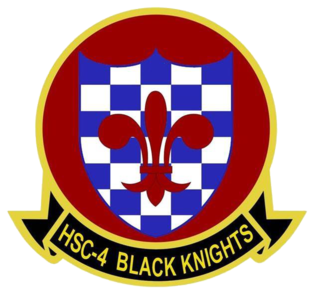
Helicopter Sea Combat Squadron Four (HSC-4), also known as the Black Knights, is a multi-role combat helicopter squadron of the United States Navy based at Naval Air Station North Island which operates Sikorsky MH-60S Seahawk helicopters deployed aboard aircraft carriers. The squadron was originally established as HS-4 on 30 June 1952 at U.S. Naval Auxiliary Landing Field Imperial Beach with the Sikorsky HO3S-1 and was redesignated HSC-4 on March 29, 2012. It is currently assigned to Carrier Air Wing Two (CVW-2) which deploys aboard USS Carl Vinson (CVN-70).

USS Ulvert M. Moore (DE-442) was a John C. Butler-class destroyer escort acquired by the U.S. Navy during World War II. The primary purpose of the destroyer escort was to escort and protect ships in convoy, in addition to other tasks as assigned, such as patrol or radar picket. Post-war she returned home bearing five battle stars; when she was reactivated for the Korean War, she returned home after that war with three more.

Helicopter Sea Combat Squadron Eight (HSC-8) "Eightballers" is a United States Navy helicopter squadron based at Naval Air Station North Island, San Diego, California. HSC-8 is attached to Carrier Air Wing 11 (CVW-11) and deploys aboard USS Theodore Roosevelt. HSC-8 was redesignated from HS-8 on 28 September 2007.
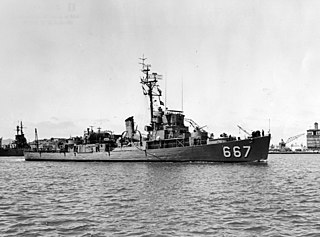
USS Wiseman (DE-667) was a Buckley-class destroyer escort in service with the United States Navy for several periods between 1944 and 1973. She was scrapped in 1974.

VP-17, nicknamed the White Lightnings, was a Patrol Squadron of the U.S. Navy.
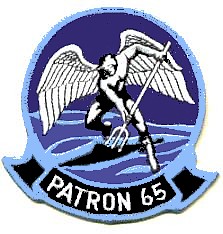
VP-65, nicknamed the Tridents, was a Patrol Squadron of the U.S. Navy Reserve. The squadron was established on 16 November 1970 at NAS Los Alamitos, California, and moved on 6 January 1971 to NAS Point Mugu. It was disestablished on 4 March 2006, after 35 years of service. Elements of the squadron made 22 major overseas deployments.

Patrol Squadron One (VP-1), established 15 February 1943, is an active aviation squadron of the United States Navy operating the Boeing P-8A Poseidon aircraft from its home port at Naval Air Station Whidbey Island, Washington, United States. The squadron is known by its nickname "Screaming Eagles", adopted in 1985 replacing its previous nickname, "Fleet's Finest". The squadron went by the call sign "BACKDOOR" during the 1960s and 1970s.
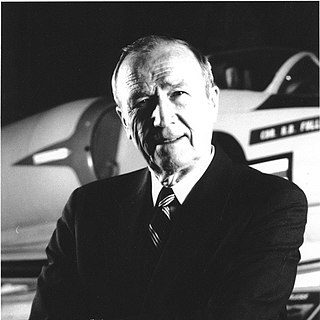
Donald Davenport Engen was a United States Navy vice admiral, former Administrator of the Federal Aviation Administration (FAA) and former Director of the National Air and Space Museum.
Sea Control Squadron 35 (VS-35), known as the Boomerangers was an anti-submarine/surface squadron of the United States Navy. Established on 3 January 1961, at Naval Air Station Los Alamitos, California, it was disestablished on 30 June 1973.


















